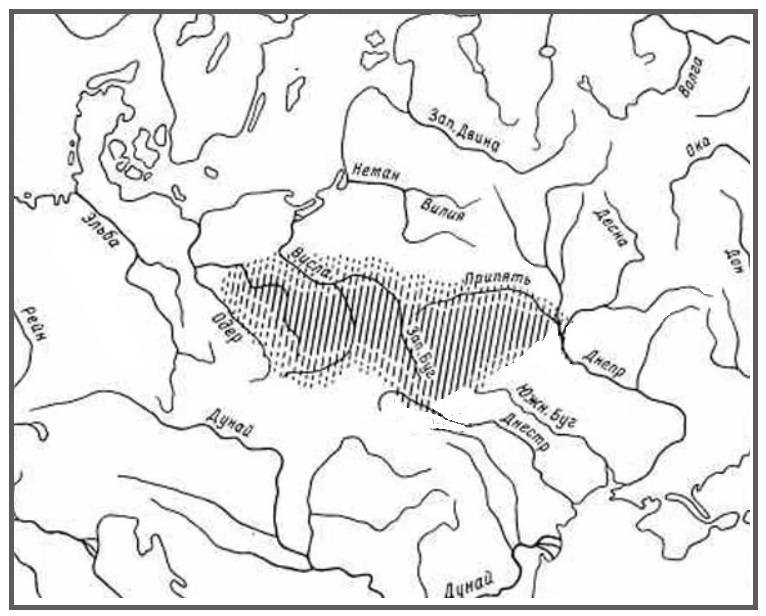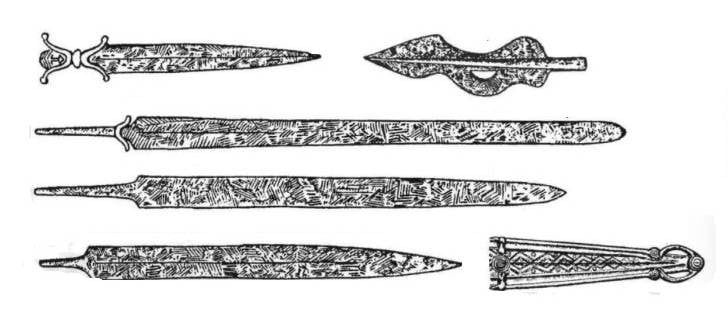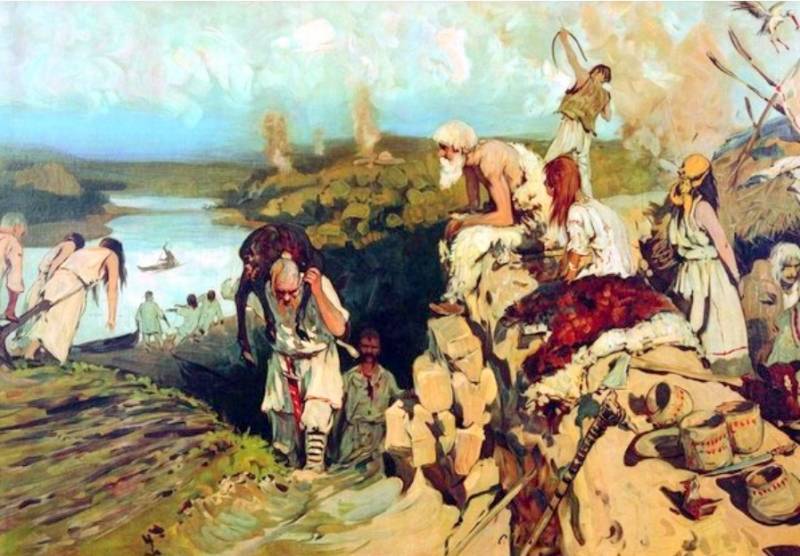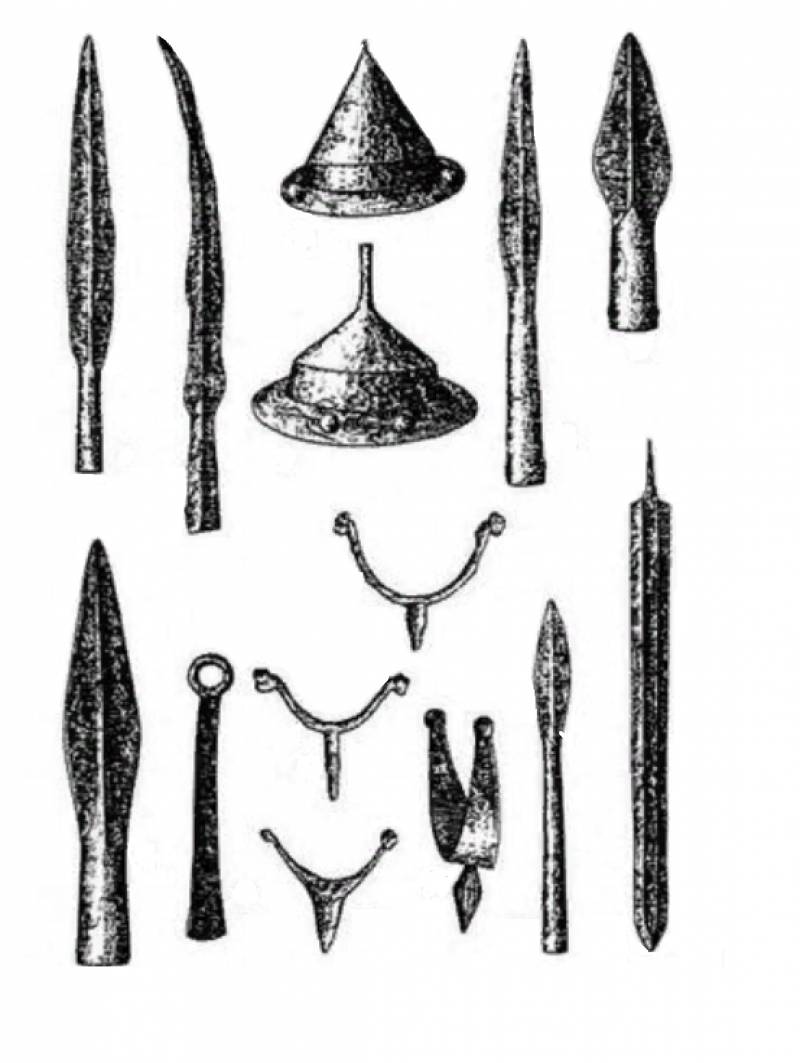The origin of the Slavs
Instead of the preface
The origin of the Slavs. This phrase itself causes more questions than answers at once.
Soviet archeologist P. N. Tretyakov wrote:
Today, even after the global work carried out by archaeologists, many works of linguists, studies on toponymy, this question remains open. The fact is that we practically have no written sources on the early history of the Proto-Slavs, and this is the stumbling block of all further reasoning. The basis of this work are key research on this topic.
Entry
At the end of the 6th century, new enemies appeared on the Danube border that hit the Byzantine state.
These were the peoples about whom the ancient and Byzantine authors had already heard, but now they became their restless neighbors, leading constant hostilities and carrying out devastating attacks on the empire.
How could the new tribes that appeared on the northern border not only compete with the military forces of the most powerful country in Europe for a long time, but also seize its lands?
How could these, yesterday unknown or little-known people of the Roman world, occupy such vast territories? What strengths and capabilities did they have, how and by whom were they involved in the global migration of peoples, how did their culture develop?
We are talking about the ancestors of the Slavs, who settled in the vast space of central, northeastern and southern Europe.
And if the fighting and battles of the Slavs VI-VII centuries. If we know well enough from written sources that have come down to us, the archaeological sites give us important information that significantly complements the picture, helps us understand many points of the early Slavic history.
The clash or cooperation of the Slavs with the nearby nations: the Byzantine Empire, the Germanic tribes and, of course, the nomads of the Eurasian plain enriched their military experience and military arsenal.
The Slavs and their military affairs are little known to the general public; for a long time they were in the shadow of the Germanic peoples living in these areas, as well as the nomadic peoples living in the Subunavia.
Origin
The Kiev chronicler in the "ethnographic" part of the "Tale of Temporary Years" wrote:
For a long time, this chronicle story was considered decisive in the picture of the settlement of Slavic tribes, today, on the basis of archaeological data, toponymy, but especially philology, the ancestral source of the Slavs is considered to be the Vistula River Basin in Poland.
Slavic language belongs to the Indo-European language family. The question of the original homeland of Indo-Europeans remains open. The Anatolian, Greek, Armenian, Indo-Iranian and Thracian languages independently emerged from the Proto-Indo-European language, while the Italic, Celtic, Slavic, Balt and Germanic languages did not exist. They constituted a single commonality of the ancient European language, and their separation took place in the course of settlement throughout Europe.
There is a debate in the literature about whether the Balto-Slavic language community was originally or whether there were long contacts between the ancestors of the Slavs and the Balts, which affected the closeness of languages. Recent studies suggest that, firstly, the Proto-Slavs had contacts only with the Western Balts (the ancestors of the Prussians), secondly, they initially had contacts with the Proto-Germanic tribes, in particular, with the ancestors of the Angles and Saxons, which is fixed in the last words . These contacts could take place only on the territory of modern Poland, which confirms the localization of the early Proto-Slavs in the Vistula-Oder interfluve.
This territory was their European homeland.
First historical evidence
For the first time messages about Venda or Slavs appear on the pages of Roman manuscripts at the beginning of our millennium. So, Guy Pliny the Elder (23 / 24 — 79 AD) wrote that Sarmatians and Veneti lived among other peoples in Eastern Europe. Claudius Ptolemy (died 178 AD) pointed out the bay, calling it Venedi, now, presumably Gdansk Bay in Poland, he also writes about the mountains of Veneda, possibly the Carpathians. But Tacitus [Gaius Cornelius Tacitus] (50-e - 120 AD) argues as follows:

The early name of the Slavs
As we have said, the ancient authors, like the ancient peoples, at the turn of the millennium, the ancestors of the Slavs called "Weeds". Many researchers believe that this term in antiquity defined not only the Slavs, but all the tribes of the Slavic-Balt language group, since this land was distant for the Greeks and the Romans and information about it was cursive, and often simply fabulous.
This word is preserved in Finnish and German, and today they are called Luga sorbs or Western Slavs - Wendel or Wende. Where did it come from?
Perhaps, according to some researchers, it was the self-name of some of the first tribal groups moving from the Vistula River basin to the west and north, to the Germanic area, and, accordingly, Finnish tribes.
Other authors believe that this was the name of a non-Slavic tribe, as described below.
K VI century. The “Wends” were clearly located in the north of Central Europe, in the west they went beyond the borders of the Oder, and in the east - to the right bank of the Vistula.
Actually the name "Slavs" appears in sources in the VI century. Jordan and Procopius, when both authors could really get acquainted with representatives of this people. Procopius of Caesarea, being the secretary of the commander Belisarius, more than once he observed and described the actions of the Slav warriors.
There is also an opinion that if the word „Veneda-Veneti“ was colloquial, then „Sklavinos“ or „Slavs“ had a book origin, such as, for example, the term „dew“.
There is no exact answer as to where this name came from. Until the nineteenth century. it was believed to be derived from the word "glory" (gloriosi). Another version, which also had until the nineteenth century, implied a connection between the word "Slav" and the "slave", a term identical in many European languages.
Modern theories suggest two solutions to this issue. The first links it with the places of the original stay of the Slavs, people living along rivers. Making it from the word "flow, water flows", hence: the river Sluya, Slavnitsa, Stawa, Stawica.
The overwhelming majority of researchers are followers of another theory; they believe that the ethnonym comes from "the word" - verbosi: speak, "speak clearly", "people who speak clearly", unlike "Germans" - cannot speak, dumb.
We meet him in the names of the tribes and modern peoples: Slovenia Novgorod (Ancient Russia), Slovaks (Slovakia), Slovenes (Slovenia and other Balkan countries), Kashubian Slovinians (Poland).
Early Slavs and Celts
In the south of the Vistula-Oder interfluve, the ancient Slavs (Przeworskaya archaeological culture) had the first contacts with the Celts who migrated to these territories.
The Celts by this time reached great heights in the development of material culture, which was reflected in the archaeological culture of Lathen (the settlement of La Ten Switzerland - La Tène). The Celtic society of Europe of this time can be defined as “heroic”, with the cult of leaders and heroes, squads and the militarization of all life, consisting of clans grouped into tribes.
The Celts made an outstanding contribution to the history of metallurgy in Europe: archeologists discovered whole forge industrial complexes.
They owned the technology of welding, hardening, made a great contribution to the production of iron tools, and, of course, weapons. A significant fact of the development of Celtic society is the process of urbanization, by the way, archaeologists associate with it a new and most important moment: from the middle of the second century. BC e. no military equipment is recorded in Celtic burials.
We know the large Celtic cities of Alesia (97 ha), Bibrakt (135 ha) and Hergovia (Clermont) (75 ha) and others.
Society moves to a new stage, in conditions of accumulation of wealth, when weapons lose their symbolic significance. It was during this period that one of the waves of Celtic migration reached the upper reaches of the Vistula in Central Europe in the 2nd century. BC e., from this moment began the interaction of the early Slavs and the Celts. From this period, the Przeworsk archaeological culture began to take shape.
Przeworsk archeological culture is associated with the early Slavs, although on its territory there are signs of habitat of both the Celts and the Germans. Monuments of archeology give great material about the development of material culture, artifacts indicate the origin of military affairs among the Slavs at the turn of the millennia.
An important factor in the interaction was the process of influence of the Celts, who are at a higher level of development, on the spiritual culture of the Slavs, which was reflected in religious buildings and burial rites. At least, what can be judged today is very likely. In particular, in the construction of a later period of the pagan temple of the Western Slavs in Arkona, on the island of Rugen, historians find features of Celtic religious buildings. But if the weapons disappear in the graves of the Celts of central Europe, then on the periphery of the Celtic world it remains, which is perfectly understandable in the framework of military expansion. And the same rite began to use the Slavs.
The participation of the Celts in the formation of Przeworsk culture led to the first major division in the history of the Slavs: in the southern (middle Europe) and northern (Powyslje). The Celtic movement in Central Europe, quite possibly accompanied by military expansion in the Vistula region, forced some of the local tribes to start moving to the Dnieper region. They go from the zone of the Vistula and Volyn to the zone of the upper Dniester and especially in the Middle Dnieper region. This movement, in turn, caused the outflow of the Baltic tribes living here (Zarubinskaya archaeological culture) to the north and east.
Although some archaeologists associate Zarubinsk culture with the Slavs.
It was during this period that the western neighbors of the ancient Slavs began to call them "Veneta". And here, too, there is a Celtic trace.
One of the hypotheses is based on the fact that the ethnonym Veneti was the self-designation of the Celtic tribes who lived in Powyslje, but when confronted with the Germans at the beginning of our era, they retreated to the lands of the north-east and southeast of modern Poland, where they conquered the Proto-Slavs and gave them their name: "Wends" or "Veneta".
Other authors believe that this was the name of a non-Slavic tribe that migrated to the south, and the neighbors began to call this name the ancestors of the Slavs who remained here.
Armament of the Slavs in the early period
Tacitus, as we see, told us a little, but this information is invaluable, since we are talking primarily about the Slavs as a settled people who live not as Sarmatians in carts, but build houses, which is confirmed by archaeological data, and that their weapons are similar to their western neighbors.
The Slavs, like most of the tribes that lived in the forest-steppe zone and entered the path of historical development, had spears as the main type of weaponry, which, of course, owes its origin to sharp-edged sticks. Given the early contacts with the Celts, whose society was at a higher stage of material development, the influence in armaments is obvious here. It was even reflected in the burial rite, when weapons or any piercing and cutting tools were damaged. So did the Celts during the burial of male warriors.
Diodorus of Sicily, (80-20 biennium BC) wrote:

In the period of early contacts with the Celts, the Slavs actively use Celtic long and narrow spearheads with well-marked edges.
Later, in the early Roman period, the Slavic copies had tips with a short leaf blade, and in the late Roman era, they had a short diamond-shaped or leaf-shaped tip, with an edge extending into a part of the sleeve.
Very early, which is unusual for a forest-steppe zone, the Slavs began to use spurs, an attribute of ammunition, which Iranian-speaking steppe horsemen of Eastern Europe did not have at that time. In the burial grounds of Przeworskaya culture, not only spearheads are found, but also spurs. Thus, the ancestors of the Slavs began early enough to use horses in combat. Perhaps it was only a warrior's delivery vehicle, as happened with many other forest peoples, for example, later Scandinavians. But the presence of spurs, which had a tetrahedral or cylindrical spike, most likely speaks of the need to control the horse and most likely during a horse attack.
Tacitus wrote that the Slavs used a shield; from archaeological finds we know that the umbons of these shields were tapered with a long spike or with a cylindrical neck, ending with a hollow spike. What sizes or parameters were shields, we can only assume, perhaps they were the same as those of neighboring nations. Probably, they were made of improvised material - wood, probably, they were covered with leather for reliability, and the umbron was attached to them. Shield handle fastened riveted through. In umbonah, the influence not only of the Celts, but also of the ancient Germans is easily visible, and through them the influence of the Romans in terms of material culture spread to the entire barbaric world of Europe.
The Slavs, as it can be supposed, have not yet reached that stage of metal processing, when it would ensure the mass production of labor tools or high-tech weapons. They are extremely rare, but used swords and Saxons.
Swords, of course, were incredibly expensive weapons, and the presence of Saxon in arms of the early Slavs again tells us about the German influence. This is a wide single-edged sword with the same production technology as the sword.
We have reached several samples of expensive scabbards or their fastenings. They testify to the high status of their owners. Of particular interest are scab shears from the sword from the Grinev burial ground (Ukrainian Griniv), a village in the Pustomytovsky district of the Lviv region of Ukraine (Upper Dniester).

The front side is decorated with a cast bronze lining depicting different scenes: a bear with a loot, a griffin, two figures, perhaps a hero and a goddess, and, finally, a horseman with a small shield and a spear. Such a decoration of weapons associated with the Celtic, and possibly with the Roman influence, and was common in Central Europe in the last century BC. er
According to archaeological sources, we cannot say that the Proto-Slavs used bows and arrows in the war, or their arrows were without metal tips. Arrowheads are scarcely found in burials from this era. Neighboring Germanic and Celtic peoples poorly used this weapon, and the influence of nomadic cultures was felt only on the southeastern border of the settlement of the early Slavs.
To be continued ...
Sources and literature:
Diodorus Sicilian. Historical Library. Books IV – VII. per. from ancient Greek., the entry article and comments O. P. Tsybenko. SPb., 2005.
Cornelius Tacitus. Writing in two volumes. SPb., 1993.
PVL. Text preparation, translation, articles and comments Likhachev D.S. SPb., 1996.
Podosinov A.V., Skrzhinskaya M.V. Roman geographical sources: Pomponius Mela and Pliny the Elder. M., 2011.
Archeology: Textbook / Edited by Academician of the Russian Academy of Sciences V. L. Yanin. M., 2006.
Babichev A.S. Commentary // Cornelius Tacitus. Writing in two volumes. C-PB., 1993.
Martynov V.V. Praradism Slavs. Linguistic beliefs. Mansk 1998.
Niederle L. Slavic Antiquities, M., 2013.
Sedov V.V. Slavs. Old Russian people. Historical and archaeological research. M., 2005
Tretyakov P. In the footsteps of the ancient Slavic tribes. L., 1982.
Shakhmatov A. A. On the issue of Finnish-Celtic Finnish-Slavic relations. Part 1-2 // Proceedings of the Imperial Academy of Sciences. 6 series. Social Sciences. 1911. H.1. No. 9. С707-724, H.2. No. 10.
Rosen-Przerworska J. Spadek po Celtach. Wroclaw; Warszawa; Krakὸw; Gdansk. 1979.


Information